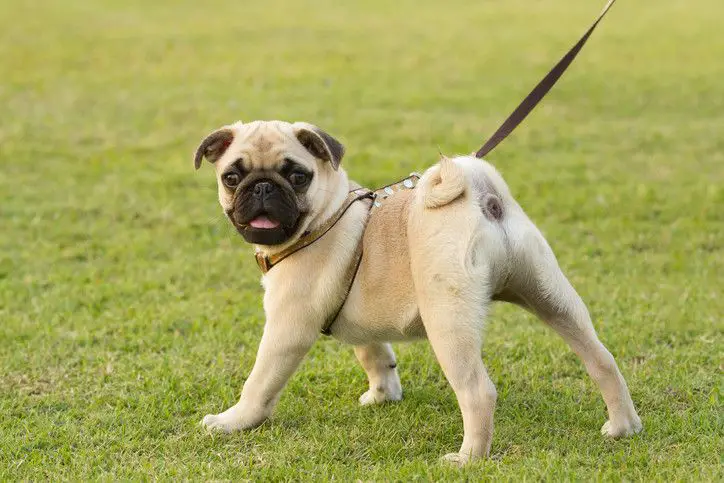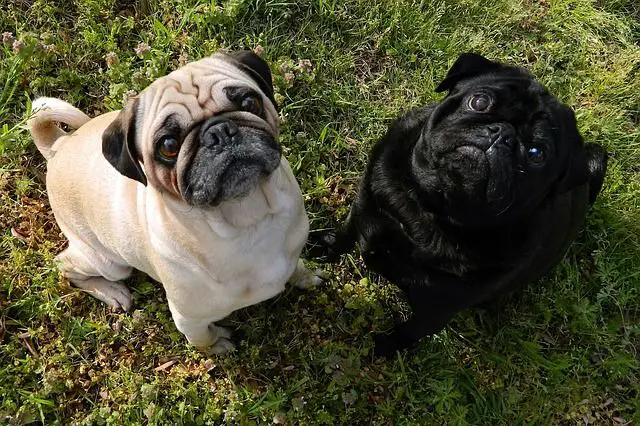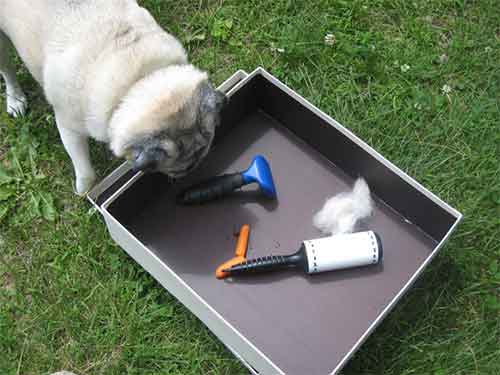Pugs are considered one of worst breeds for shedding and this immediately cause concerns for new owners.
Do pugs shed a lot? The simple answer to this is yes, and there is little to do to stop it.
The trick to embracing the seemingly endless shedding of pug fur is to stay in control and make sure that it does not become excessive.
In this guide, we will look at some of the key questions that prospective pug owners are worried about.
Do pugs shed a lot more hair than other breeds?
Do Black pugs shed less or is that just a myth?
Is it really possible to keep all this fur loss under control?
Shedding is an important consideration when becoming a pug owner, but it is not all bad news if you follow the right tips and have the right attitude.
With these grooming tips, the health care advice and other important information about breed variants and coats, you can keep pug shedding under control.
Table of Contents
Do pugs shed more in spring or do pugs shed more in summer?
This is a common question from pug owners because there will be times when your dog seems to lose more fur, and seasonal moults can be common in other breeds.
Answers will vary depending on who you talk to and sometimes also on location.
There are those that don’t really pay attention to the season because their dog seems to constantly shed a lot, while others will point out that the indoor lifestyle of the pug means that seasonal changes are less pronounced.
This doesn’t mean that there isn’t a seasonal moult, however As the coat begins to thicken up for winter, the new growth will force out the old hair from those dense layers.
Also, more will be shed in late spring when the coat starts to thin out again.
Black pugs vs fawn pugs shedding: which is worse?
The other common question that leads to some mixed responses regards the colour of the pug.
Do black pugs shed less than fawn pugs, as many suspect?
While there are some owners of black pug that would say that black pug shedding is just as bad, fawn pugs are physically pre-determined to shed more.
A black pug only has one coat of hair while the fawn pug has a double coat. Not only does this simply mean more hair for the fawn pugs to lose all over the home, the undercoat pushes out hairs on the upper coat in growth, leading to faster hair loss.
Will getting a puggle reduce the risk of shedding?
Because pugs of both varieties still shed a lot of fur, whether they have the black pug’s single coat or not, some potential owners may wonder about the coat of puggles.
Puggles are a cross breed between a pug and a beagle, with an interesting blend of characteristics and fewer breathing problems.
They are a great option for dog lovers that are not set on owning a pure breed pug and simply want the loyalty and playful nature of that kind of toy breed.
The problem is that puggles shed just as much as both their parent breeds; they have not been bred for a better coat. Also, owners should note that puggles have the double coat of fawns, not that more manageable single coat, so there is plenty of hair to lose.
Puggles are charming dogs, but they may require similar amounts of grooming and treatment as pure pugs.
Also, you could still find your puggle shedding excessively due to some of the same issues.
Whichever you choose, you will quickly learn the that the answer to how bad do pugs shed is pretty bad. It is an endless battle at times.
Many pug owners simply put up with the constant cleaning and say that it is all part of the joy of being a pug owner.
Some resort to a regular cleaning regime with lint brushes, tape rollers, pet hair vacuums and anything else that keeps the hair at bay for a little while longer.
- Included Components: Bissell - Pet Hair Eraser Bagless Hand Vac - Black Pearl.40.0 watts
- Power Source Type: Corded Electric
Last update on 2025-01-10 / Affiliate links / Images from Amazon Product Advertising API
Some will train their pug to only lie on rugs and throws that can be easily laundered in the washing machine – although the hair still has a habit of travelling to places that the dog hasn’t even visited.
Shedding may be an inevitable part of the job, but it is an issue that should not be ignored.
A good grooming regime can help to keep the problem under control and it is always worth making sure that the fur loss does not become excessive.
Dealing with pug hair shedding through grooming techniques
Regular grooming is one of the best methods for dealing with access fur because it is easy to manage and can really have a big impact on the amount of fur that is shed across the house.
The only potential drawback to this consistent effort is that you will probably have to carry it out indoors – unless you and your pug are patient and hardy enough to do so in the back yard.
The best setup is to place a grooming mat on a table in a room with an easy-clean floor. This way your dog is raised up at a comfortable level and you have less vacuuming to contend with.
It can be a long, precise process at times, but the great news is that the majority of pugs enjoy being groomed.
Pugs are keen to get our attention, no matter the circumstances, and half an hour of grooming is not a chore to them when they are the centre of attention and are essentially being petted the whole time.
It should not take long before you both appreciate the rewards for the efforts of grooming, especially if you train your pug puppy to be groomed from an early age.
Brushing pugs to reduce shedding
Many pug owners will suggest that you brush your pug every day to cut down on the amount of dead hair that is lost across the furniture and carpets, but a gentle stroke here and there will only do so much.
Regular grooming sessions mean taking the time to go over the entire body – head to tail and onto the belly, to brush out the entire coat. If you have a fawn pug, this means plenty of effort to get into that dense undercoat too.
A well-trained, happy pug will roll over for you and enjoy the attention.
A thorough grooming session also gives you the chance to check for other issues, such as skin complaints, parasites and lumps, and the motions help to stimulate blood flow.
A good regime means some effective tools so what are the best brushes for pugs?
Some owners use little more than a basic brushing mitt and a wire brush to get into the coat for a smooth, even process.
A product that comes recommended by many owners is the Kong Zoom Groom, which attracts the hair and allows for a great result without being harsh. From there, it may help to have a de-shedding tool, especially in those difficult seasonal periods.
These tools grab hold of the dead hairs that get trapped in the coat, which is easily done in the layers of a pug coat, and allow for more hair to be removed at once.
Finally, because you are sure to be covered in pug hair by the end of the session, it helps to keep a lint brush handy.
Bathing pugs to reduce shedding
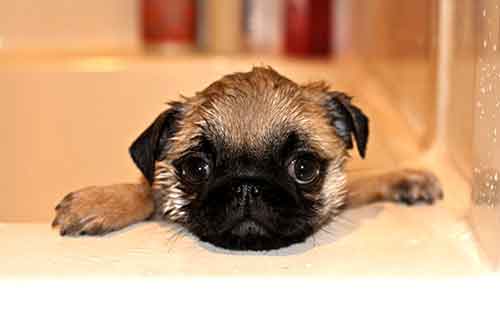 Image Source: aboutpug.com
Image Source: aboutpug.com
Regular brushing is a must for keeping pug hair under control but bathing can be a great help too.
Again, bathing a pug does not have to be a chore because they love the attention and don’t seem to mind getting wet this way.
One bath a month should be enough to ensure a healthy coat and to wash out all the loose hair and dirt that may be trapped in the coat. Make it a game with plenty of praise and treats, but be sure to keep their welfare in mind at all times.
One of the biggest issues that pug owners face when bathing their dogs is using the right products.
It should go without saying that harsh chemical products for humans are to be avoided, but you also need to choose the right dog shampoo.
Pugs can be susceptible to dermatitis and their big ears are prone to irritation.
Be sure to use a mild, hypoallergenic shampoo that works with the coat and skin and be careful when cleaning near the eyes and ears.
Once you have cleaned your pug and all the shampoo is completely rinsed off, you need to dry them off.
Unlike other breeds, which can be left to run around and air dry, you need to be careful to dry a pug coat thoroughly because of the risk of trapped moisture in the skin folds. This can lead to odour and other problems.
Pugs also take a long time to dry naturally because of those thick layers.
Towel dry in all the crevices and either finish the job with a low setting on a hair dryer or a warm patch of sunshine.
Be careful with using hairdryers too much because you don’t want to dry out the hair and weaken it.
What to do if you think your pug is shedding excessively
The secondary concern when considering the question of how much do pugs shed is that of excessive shedding.
There may be times when your pet seems to be shedding a lot more than normal, perhaps out of season.
You should also watch out for pug hair loss – unexplained areas of bare skin, or red, inflamed areas that may indicate a bigger problem. Talk to a vet to locate any health or dietary issues that may be causing the problem.
Health problems that can make a pug shed a lot of fur
As with most dogs, there are potential health issues that pug owners need to be aware of when dealing with a dog that is shedding a lot.
As was mentioned above, pugs are prone to certain skin conditions and dermatitis, which can make the skin itchy and potentially lead to abnormal fur loss.
In addition to be being careful with products and the climate of the house, it is important to change for mites and allergens that could exacerbate the situation. Red mange, for example can cause hair loss and will need to be treated by a vet.
One of the bigger issues for pug owners is that of hormone levels. A pug’s hormones can play an important role in the amount of fur that they lose and changes can occur at different times.
There are some medical conditions that will affect hormone levels, such as thyroid issues. A breeding cycle is a more common indicator of hormonal changes, such as when a bitch comes into heat or have just given birth to a litter.
These radical changes are nothing to worry about in the short term, and the hair loss will probably right itself in due course, but it is worth checking for stress levels.
If a dog remains stressed during this period, or for any other reason, get them checked out.
Finally, there is also a big hormonal shift in puppies as they mature into adults, not only can this affect well-being, there is the big moult of the puppy coat to consider.
A pug’s diet can also affect the amount of hair that they lose.
A dog’s diet is one of the last things that we tend to think of when we consider the quality of their coat, especially if we are careful to groom and bathe them, but the right diet can ensure that they get all the nutrients they need for hair growth and conditioning.
A vet can advise you on the best food to give a dog that may be struggling with hair loss.
A healthy diet should be enough in a healthy dog, but those with skin problems or excessive shedding may need a little extra help with some vitamins and other components.
Dietary supplements are a great aid for reducing shedding, when they are used responsibly.
Some vets would prefer to see pugs maintain their coats through a strong diet alone, but it some cases they will be able to help with supplementation.
Increased vitamin A can help, but the most common option is to increase levels of fatty acids.
Fish oil capsules and liquids full of Omega 3 can make a big difference. Some pug owners suggest adding a tablespoon of flaxseed or olive oil to food instead, but it is worth consulting with a vet before going it alone.
Is it possible to find pugs that don’t shed?
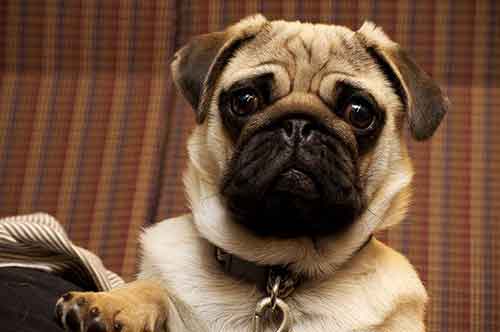 Image Source: Pixabay
Image Source: Pixabay
Excessive shedding in pugs can be overcome, but you will still be left with a lot of fur from a healthy dog.
If the idea of all this constant grooming, maintenance and health checks is putting you off from becoming a pug owner.
There may be one more question on your mind: is it at all possible to find non shedding pugs or a more straightforward solution to the problem?
The simple answer to this is no.
no matter what pug you get, they will shed their hair at a steady rate and require all the time and attention mentioned above.
Some owners may decide that shaving pugs is the best solution to the problem as it cuts down the amount of hair that is left to shed. This may seems like a quick fix solution as an owner, but it is not good for the dog.
A pug with hair is a healthy, happy pug, and surely a more attractive one too.
Their protective coat is vital for temperature regulation. It keeps them warm in the winter and cool in the summer and is designed to offer the best protection for their skin. Shave it off and you run the risk of ruining its effects, damaging the hair and – if it is not done professionally – a bad look.
Summary:
pugs shed all year round and it is something you are just going to have to embrace.
In answering the important question of do pugs shed?, we have learnt that not only do pugs shed hair a lot, they require plenty of care and attention to keep it under control.
You cannot get a pug that doesn’t shed, shave a pug’s coat or ignore the issue. Instead, be aware of potential issues that may lead to excessive shedding, maintain the coat with baths and dietary supplements and enjoy the grooming process when your pugs are healthy.
The seasons and a pup’s hormones can affect the amount shed, but there is generally just a steady stream of lost fur that can be dealt with through regular brushing and health care.
Pugs love grooming and will appreciate the effort spent on keeping their coat clean and healthy.
If you are serious about being a pug owner and love the breed, you simply have to accept that this is part of the territory.

